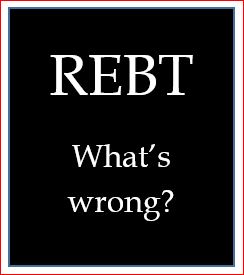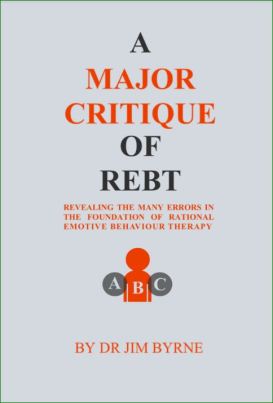Blog Post No.117
Posted on 13th March 2017 – (Originally posted on 5th February 2015).
Dr Jim’s Counselling Blog: A counsellor blogs about John Reinhard’s misquoting of Dr Byrne’s book about the childhood of Albert Ellis…
Copyright ©Jim Byrne, 2015/2017
Introduction
Isn’t it annoying when readers of your work completely misrepresent what you said!
This happened to me in the case of a book I wrote about Dr Albert Ellis, which was slated by an Ellis fanatic.
 I wrote a book on the childhood of Albert Ellis (currently out of print), with the intention of correcting the mistakes that persist in REBT (and presumably in derived-forms of CBT), which arose out of the psychological trauma inflicted upon Little Albert Ellis by his seriously neglectful parents. My hope was that followers of REBT would take this critique seriously, and set about reforming REBT to make it less distorted by Ellis’s unresolved neuroses – mainly his avoidance of emotion (in the form of his Extreme Stoicism), and his (largely successful) attempts to suppress all thought of childhood trauma, in himself or anybody else.
I wrote a book on the childhood of Albert Ellis (currently out of print), with the intention of correcting the mistakes that persist in REBT (and presumably in derived-forms of CBT), which arose out of the psychological trauma inflicted upon Little Albert Ellis by his seriously neglectful parents. My hope was that followers of REBT would take this critique seriously, and set about reforming REBT to make it less distorted by Ellis’s unresolved neuroses – mainly his avoidance of emotion (in the form of his Extreme Stoicism), and his (largely successful) attempts to suppress all thought of childhood trauma, in himself or anybody else.
In three earlier posts, I have addressed some of the ways in which one of Ellis’s followers – one John Reinhard – has failed to engage with my critique.
Today I went back to see how selectively Reinhard had dealt with my criticism of the inadequacies of REBT therapists when it comes to the question of empathy for the client.
I was appalled at how little attention he’s paid to my actual arguments. Here is the whole of the relevant section of my book.
- Tell me if you consider that I have said “REBT therapists skip all forms of empathy”.
- Tell me if I’ve in any way misrepresented the actual position that Ellisian REBTers take on the subject of empathy in psychotherapy.
Here is the foreword of that book:
Foreword
“If it was never possible for us to relive on a conscious level the rejection we experienced in our own childhood and to work it through, then we in turn will pass this rejection on to our children”. Dr Alice Miller[1]
 This book represents an attempt to deconstruct Dr Albert Ellis’s story of his childhood, with a view to rescuing ‘Little Albert’, who has been ignored and discounted by Older Albert, just as he was ignored and discounted by his own parents. It also seeks to evaluate his theory of therapy (REBT), and to try to identify links between his major childhood experiences and his adult theories of human behaviour.
This book represents an attempt to deconstruct Dr Albert Ellis’s story of his childhood, with a view to rescuing ‘Little Albert’, who has been ignored and discounted by Older Albert, just as he was ignored and discounted by his own parents. It also seeks to evaluate his theory of therapy (REBT), and to try to identify links between his major childhood experiences and his adult theories of human behaviour.
Why do I want to do this? What is my goal?
I am doing this because, as it stands, Albert Ellis’s system of therapy – called Rational Emotive Behaviour Therapy (REBT) – and those therapies which have been inspired by him, which includes most of the cognitive behavioural therapies – ignores the childhood pain of counselling and therapy clients; and recommends that they “forget the god-awful past”. In the process, those rational counsellors and therapists unknowingly promote an unnecessarily callous attitude towards client suffering, and an indifference towards childhood suffering in general.
On the other hand, I suffered emotionally as a child, and only managed to recover from that seriously damaging experience by processing it – making it conscious; feeling the previously denied or repressed feelings; and moving on.[2] I resolutely refused to try to “forget the god-awful past” – partly because it’s actually the non-remembered bits that do the most harm; and we have to remember them first, process them, and file them away, before we can healthily forget them!
Cognitive empathy versus emotional empathy
I am not saying that REBT/CBT therapists show no empathy for their clients whatsoever: they do. But their empathy seems to be mainly ‘cognitive’ – or cool ‘understanding’ – instead of also including some ‘felt affinity’ with the suffering client. (Of course there are exceptions to this rule, and Janet Wolfe is the main one I have seen on video, warmly empathizing with a client who she judged to be “in need of tender loving care [TLC])”. That felt sense of affinity with the client – when it occurs – is experienced by the client as both caring for them, and also legitimating their sense of having been wronged or short-changed by life. An REBT /CBT therapist might be concerned that this kind of emotional affinity could encourage the client to ‘catastrophize’ about their childhood suffering, but this is not a necessary outcome from emotional empathy.
For example, in both the therapy work of Milton Erickson[3] and the coaching work of Stephen Covey[4], the emphasis is on, firstly, understanding and empathizing with the client – and showing a sense of fellow feeling; and then, secondarily, trying to show the client some potentially better ways of thinking-feeling-acting in their problem situation. Why does the REBT/CBT therapist have to urgently skip that first essential step? Why not bide their time until the client feels understood, before presenting their proposed solutions and improved ways of thinking, feeling and acting?
And even in the case of offering cognitive empathy, the REBT/ CBT therapist (who follows Ellis’s lead) is likely to only empathize with those aspects of life’s difficulties which are seen as ‘legitimate’. And that tends to exclude childhood suffering. (Albert Ellis has been shown – in some video clips of his therapy work – to empathize with people who feel guilt or shame, [presumably because he thinks nobody should ever have to feel guilt or shame – which I will show to be an unhelpful approach when it comes to moral issues]. But he does not empathize with:
(a) individuals who feel they need a loving partner, (presumably because he does not believe anybody needs to be loved);
(b) people who suffered in their childhood, (presumably because he believes they have a duty to ‘forget the god-awful past’ – like he did!)
(c) people who complain of being treated unfairly, (presumably because he foolishly thinks that this is always and only beyond the control of the client – which it [very often] most definitely is not!)
In this book, I am seeking to help children, and the inner child of adult clients, by promoting empathy for victims of childhood suffering. This empathic understanding is a necessary precedent to the process of completing those painful experiences, reframing them, and then letting them go[5]. In addition, I also want to rescue what is good about REBT, while dumping what is un-helpful.
It is my belief that Little Albert Ellis suffered enormously, but that Older Albert Ellis was in denial about that suffering. As such, Older Albert was never able to become a self-actualized individual, in the fullest sense: especially in relation to his capacity to love and to relate warmly and intimately to others (although he began to make apparent improvements with Debbie Joffe-Ellis, after the age of 88 years!) And as a therapist, he was unable to fully, emotionally, empathize with the childhood suffering of his clients.
If you think you ‘already know’ Albert Ellis and REBT, then prepare for a shock. You are about to be introduced to their normally ignored ‘shadow sides’.
And if you think there is only one way to relate to Albert Ellis – to love him or hate him – prepare to be introduced to the ‘middle way’.
~~~
End of extract… From The Childhood of Albert Ellis…***
That’s all for now.
Best wishes,
Jim
Dr Jim Byrne, Doctor of Counselling
ABC Coaching and Counselling Services
Email: jim.byrne@abc-counselling.com
~~~
Here is a link to my major critique of REBT:
A Major Critique of REBT:
Revealing the many errors in the foundations of Rational Emotive Behaviour Therapy

This book is a devastating critique of the foundations of REBT. There was a need to clarify the bottom line of Dr Byrne’s 500 page critique of REBT, and that has been done in a 22 page preface to this reissued, 2019 edition. (This has now also been released as a low-cost, Kindle eBook, on 31st January 2020).
Also, we have added a reference to the research which shows that emotional pain and physical pain are both mediated and processed through significantly overlapping neural networks, which contradicts Dr Ellis’s claim that nobody could hurt you, except by hitting you with a baseball bat or a brick.
This is a comprehensive, scientific and philosophical critique of the foundations of Rational Emotive Behaviour Therapy, as developed by Dr Albert Ellis; including the dismantling of the philosophical foundations of the ABC model; and a decimating critique of the concept of unconditional self-acceptance. Almost nothing is left of REBT when the dust settles, apart from the system called Rational Emotive Imagery, which Dr Ellis borrowed from Maxi Maultsby.
Available in paperback and eBook formats.
Price: £23.58 GBP (Paperback) and £6.99 GBP (Kindle eBook).
~~~
Footnotes
[1] Miller, A. (1983) For Your own Good: Hidden cruelty in child-rearing and the roots of violence. London: Faber and Faber. Pages 3-4.
[2] See my Story of Origins and my Story of Relationship – two ‘training analyses’ – here: https://ecent-institute.org/e-cent-articles-and-papers/
[3] See the book, My Voice will Go with You: The teaching tales of Milton H. Erickson. Edited and with commentary by Sidney Rosen. 1982. New York: W.W. Norton & Company. Erickson is quoted as saying: “First you model the patient’s world” – which means understanding it – “Then you role-model the patient’s world” – meaning you provide a new and better model for the client to consider adopting.
[4] The 7 Habits of Highly Effective People. A book by Stephen Covey (1989), in which his fifth principle is: Seek first to understand, and then to be understood. An REBT therapist could apply this principle to first allow the client to have their thoughts and feelings; to accept them; validate them; and then to look at whether it might be better for the client if they were moderated or modified in some way. But jumping to that second stage immediately is probably often felt to be insensitive and discounting by the client.
[5] Byrne, J. (2011a) Completing your experience of difficult events, perceptions and painful emotions. E-CENT Paper No.13. Hebden Bridge: The Institute for Cognitive Emotive Narrative Therapy. Available online: https://ecent-institute.org/e-cent-articles-and-papers/
